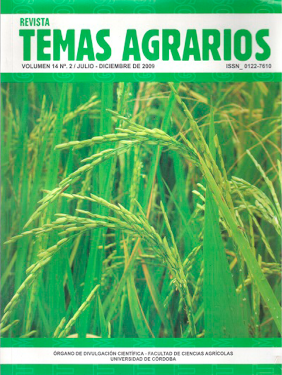Bioconversión de Xilosa a Xilitol por Candida Guilliermondii Empleando Cascarilla de Arroz (Oriza sativa).
Bioconversion of xylitol to xylose by Candida guilliermondii using rice (Oriza sativa) husk.

Esta obra está bajo una licencia internacional Creative Commons Atribución-NoComercial 4.0.
Mostrar biografía de los autores
El objetivo fue la obtención de xilitol a partir del hidrolizado de cascarilla de arroz por fermentación batch con cepa nativa Candida guilliermondii, aislada del fruto de corozo chiquito (Bactris guineensis). El estudio se dividió en dos partes: Obtención del hidrolizado hemicelulósico por vía ácida a partir de cascarilla, evaluándose los efectos de concentración de acido sulfúrico (1, 2 y 3% p/v), el tiempo de hidrólisis (10, 20 y 30 minutos) y el diámetro de cascarilla (800 -1.600 µm, 800 – 500 µm y 500 – 250 µm) en la producción de azúcares reductores. En ésta parte se determinó que el hidrolizado obtenido a un tiempo de 30 minutos, 2% de ácido sulfúrico y diámetro de partícula de cascarilla de 800 – 500 µm presentó mayor contenido de azúcares reductores (32,5 g L-1) y de xilosa (9,9 g L-1). En la segunda parte se obtuvo xilitol empleando el hidrolizado seleccionado y realizando fermentación a temperatura de 30 ºC, pH del medio de 5,8, agitación de 120 rpm, concentración de xilosa de 27,5 g L-1 y de células de 3 g L-1. La producción de xilitol se evaluó por cromatografía de capa fina (TLC) y líquida de alta resolución (HPLC). Los resultados mostraron que el tiempo de fermentación tiene un efecto significativo (Pr< 0,05) en la producción de xilitol debido a que a mayor tiempo de fermentación se incrementa la concentración de xilitol en el medio. La producción de xilitol fue baja en las condiciones empleadas, siendo el rendimiento máximo de xilitol de 2,6 g L-1 después de 120 h de fermentación.
Visitas del artículo 1571 | Visitas PDF
Descargas
- Aguiar, W., Faria, L., Araujo, O. y Pereira, N. 2002. Growth model and prediction of oxigen transfer rate as a function of inoculum size for Xylitol production from D-xylose for Candida gilliermondii. Biochemical Engineering Journal 12(1):49-59.
- Fennema, O. 1993. Química de los alimentos. Editorial Acribia S.A., Zaragoza, p23-24.
- Keikhosro, K., Shauker, K. y Mohammad, J. 2006. Conversión of rice straw to sugars by dilute-acid hydrolysis. Biomass and Bioenginnering (30):247-253.
- Mäkinen, K. 2000. Can the pentitol-hexitol theory explain the clinical observation made with xylitol. Medical hypotheses (54):603-613.
- Martínez, E., Villarreal M., Almeida, J., Solenzal, A., Canilha, L. y Mussato, S. 2002. Uso de diferentes materias primas para la producción biotecnológica de xilitol. Ciencia y Tecnología Alimentaria 3(5):295–301.
- Mussato, S. y Roberto, I. 2004. Kinetic behavior of Candida guilliermondii yeast during xylitol production from highly concentrated hydrolysate. Process biochemistry 39:1433–1439.
- Mussatto, S., Dragone, G. y Roberto, I. 2005. Influence of the toxic compounds present in brewer’s spent grain hemicellulosic hydrolysate on xylose-to-xylitol bioconversion by Candida guilliermondii. Process Biochemestry 40:3801-3806.
- Parajo, J., Domínguez H. y Domínguez J. 1998a. Biotechnological production of xylitol. Part 3: operation in culture media made from lignocellulose hydrolysates. Bioresource Technology 66:25-40.
- Roberto, I., Mussatto, S. y Rodríguez, R. 2003. Dilute-Acid Hydrolysis for Optimization of Xylose Recovery from Rice straw in a Semi-Pilot Reactor. Industrial Crops And Products 17:171-176.
- Sampaio, F., Mantovani, H., Passos, F., De Moraes, C. y Converti, A. 2005. Bioconversion of D-xylose to Xylitol by Debaryomices hansenii UFV-170. Process Biochemistry 40(11):3600-3606.
- Santos, J., Carvalho, W., Silva, S. y Converti, A. 2003. Xylitol production from sugarcane bagasse hydrolysate in fluidized bed reactor, effect o air flowrate. Biochemical Engineering Journal 25:25-31.
- Silva, C. y Roberto, I. 2001a. Optimization of xylitol production by Candida guilliermondii FTI-20037 using response surface methodology. Process Biochemestry 36:1119-1124.
- Silva, C. y Roberto, I. 2001b. Improvement of xylitol by Candida guilliermondii FTI 20037 previously adapted to rice straw hemicellulosic hydroliysate. Applied Microbiology 32(4):248-252.
- Silva, C., Mussatto, S. y Roberto I. 2005. Study of xylitol production by Candida guilliermondii on a bench bioreactor. Journal of Food Engineering 75:115–119.
- Timothy, D. y Bruce S. 1999. Xylitol production from corn fibre hydrolyzates by a two-stage fermentation process. Process Biochemestry 35:765-769.
- Yufera E. 2002. Tecnología de Cereales. Editorial Acribia, Zaragoza, 337p.




















